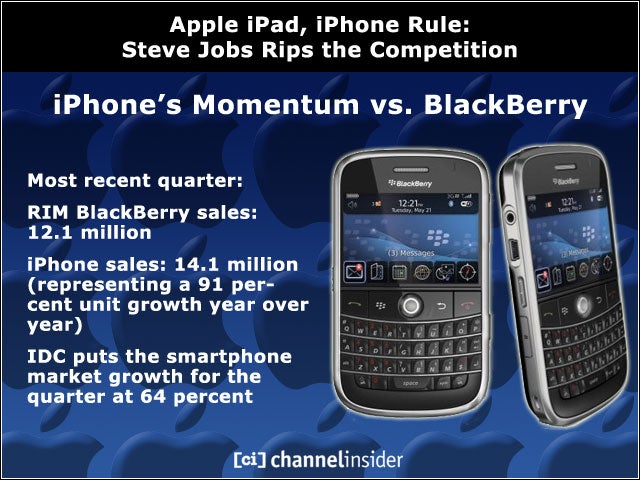 iPhone’s Momentum vs. BlackBerry
iPhone’s Momentum vs. BlackBerryMost recent quarter:
RIM BlackBerry sales: 12.1 million
iPhone sales:
14.1 million (representing a 91 percent unit growth year over year)IDC puts the smartphone market growth for the quarter at 64 percent
 “We’ve Passed RIM”
“We’ve Passed RIM”
Jobs: “We’ve now passed RIM, and I don’t seem them catching up with us in the foreseeable future…It’s going to be a challenge for them to create a competitive platform and to convince developers to create apps for yet a third software platform after iOS and Android. With 300,000 apps on Apple’s App Store, RIM has a high mountain ahead of them to climb.”
 What about Google?
What about Google?Google reports activating 200,000 Android devices per day.
Android App store: 90,000 apps.
Apple reports activating around 275,000 iOS devices per day on average for the past 30 days with a peak of almost 300,000
300,000 apps.
 Android Open, iOS Closed?
Android Open, iOS Closed?
Jobs: “Google loves to characterize Android as open, and iOS and iPhone as closed. We find this a bit disingenuous and clouding the real difference between our two approaches…Android is very fragmented. Many Android OEMs, including the two largest, HTC and Motorola, install proprietary user interfaces to differentiate themselves…Compare this with iPhone, where every handset works the same.”
 Developer Friendly
Developer Friendly
Jobs: Android’s “multiple hardware and software iterations present developers with a daunting challenge. Many Android apps work only on selected Android handsets running selected Android versions. And this is for handsets that have been shipped less than 12 months ago. Compare this with iPhone, where there are two versions of the software, the current and the most recent predecessor to test against.”
 App Store Complexity
App Store Complexity
Jobs: “Amazon, Verizon and Vodafone have all announced that they are creating their own app stores for Android. So there will be at least four app stores on Android, which customers must search among to find the app they want and developers will need to work with to distribute their apps and get paid. This is going to be a mess for both users and developers.”
 Android is Fragmented
Android is Fragmented
Jobs: “We think the open versus closed argument is just a smokescreen to try and hide the real issue, which is, what’s best for the customer, fragmented versus integrated. We think Android is very, very fragmented and becoming more fragmented by the day. And as you know, Apple’s strives for the integrated model so that the user isn’t forced to be the systems integrator.”
 Tablet’s Coming to Compete with iPad
Tablet’s Coming to Compete with iPad
Jobs: “I’d like to comment on the avalanche of tablets poised to enter the market in the coming months. First, it appears to be just a handful of credible entrants, not exactly an avalanche.”
 (Screen) Size Matters
(Screen) Size Matters
Jobs: “Almost all of [the tablets on the way] use seven-inch screens as compared to iPad’s near 10-inch screen… A 7-inch screen is only 45 percent as large as iPad’s 10-inch screen…If you take an iPad and hold it upright in portrait view and draw an imaginary horizontal line halfway down the screen, the screens on the 7-inch tablets are a bit smaller than the bottom half of the iPad display. This size isn’t sufficient to create great tablet apps in our opinion.”
 Screen Size and Touch
Screen Size and Touch
Jobs: “One could increase the resolution of the display to make up for some of the [size] difference. It is meaningless, unless your tablet also includes sandpaper, so that the user can sand down their fingers to around one quarter of the present size…There are clear limits of how close you can physically place elements on a touch screen before users cannot reliably tap, flick or pinch them. This is one of the key reasons we think the 10-inch screen size is the minimum size required to create great tablet apps.”

 Android Won’t Work for Tablets
Android Won’t Work for Tablets
Jobs: “Even Google is telling the tablet manufacturers not to use their current release, Froyo, for tablets, and to wait for a special tablet release next year. What does it mean when your software suppliers says not to use their software in your tablet? And what does it mean when you ignore them and use it anyway?”
 iPad’s App Momentum
iPad’s App Momentum
Jobs: “iPad now has over 35,000 apps on the App Store. This new crop of tablets will have near zero.”
 We’ll Win on Pricing, Too
We’ll Win on Pricing, Too
Jobs: “Our potential competitors are having a tough time coming close to iPad’s pricing, even with their far smaller, far less expensive screens. The iPad incorporates everything we have learned about building high value products from iPhones, iPods and Macs. We create our own A4 chip, our own software, our own battery chemistry, our own enclosure, our own everything. And this results in an incredible product at a great price. The proof of this will be in the pricing of our competitor’s products which will likely offer less for more.”
 DOA
DOA
Jobs: “These are among the reasons we think the current crop of seven-inch tablets are going to be DOA, Dead on Arrival. Their manufacturers will learn the painful lesson that their tablets are too small and increase the size next year, thereby abandoning both customers and developers who jumped on the 7-inch bandwagon with an orphan product. Sounds like lots of fun ahead.”

